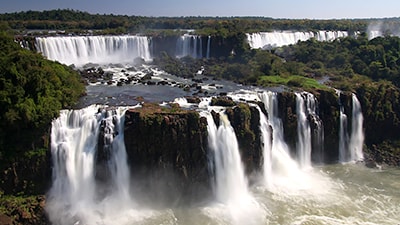Emissions from Brazil’s Proposed Hydroelectricity Reservoirs May Be Higher Than Predicted
By Emily DurhamCarnegie Mellon University researchers have published an article that suggests some of Brazil’s proposed hydropower plants in the Amazon, a widely regarded “clean” energy source, have the potential to emit higher levels of greenhouse gases than previously predicted.
Brazil’s growing demand for electricity has led policymakers to propose widespread construction of hydropower plants as a solution for the future. The Brazilian energy plan states that by 2022, 85 percent of new hydropower generation capacity will come from hydroelectric power plants in the Amazon region. Hydroelectricity, a power industry based on capturing the energy of falling water, relies on the construction of large reservoirs of water walled off with dams to control the water’s flow.
Hydropower plants have historically been lauded for their environmental benefits, because it is thought they emit lower amounts of carbon into the atmosphere than other energy sources. However, the proposed large-scale development of reservoirs in the Amazon has set off a red flag for Department of Engineering and Public Policy Assistant Professor Paulina Jaramillo and Ph.D. student Felipe Faria. In “Environmental Research Letters,” Jaramillo and Faria point out that certain specific hydropower reservoirs already existing in the Amazon have been reported to emit greenhouse gases comparable those of thermal power plants.

“Greenhouse gas emissions from reservoirs are usually low, especially in subtropical, temperate and boreal zones,” Faria explained. “However, the literature from the last few years has shown that this was not the case for reservoirs located in tropical forests. Greenhouse gas measures in tropical dams showed high methane and carbon dioxide emissions because of the degradation of organic matter present in the vegetation and soils.”
Jaramillo and Faria’s article, titled “Estimating Greenhouse Gas Emissions from Future Amazonian Hydroelectric Reservoirs,” offers two new models based upon a framework that takes into account greenhouse gases released into the air when converting land and rivers into a hydropower reservoir.
“The construction of large hydropower reservoirs results in several impacts to the environment, because an artificial lake substitutes the ‘natural’ river and land,” said Jaramillo, a researcher in CMU's Scott Institute for Energy Innovation. “As a result, the dam interrupts the natural flow of the river, changing the nutrient balance and shifting the oxygen, thermal and sediment patterns. The fragmentation of the river affects migration of aquatic species and the flooding of large areas also harm local biodiversity.”
The models predict that over a hundred years, the proposed hydropower plants could not only have a significant impact on the local environment, but may also be a source of greenhouse gas emissions that contribute to global climate change. Should the predicted highest levels of greenhouse gases be emitted, the hydropower plants could emit greenhouse gases comparable to fossil fuel sources.
“If the emissions are as high as the [improbable] upper bound,” Faria explains, “it means that specific dams with a low energy density will have higher emissions in comparison to other energy sources, including fossil fuels. Hence, these reservoirs will contribute to, rather than mitigate climate change.”
Researchers in CMU's Scott Institute for Energy Innovation are working to create new solutions, new products and new ways of doing things in a variety of areas, to make energy more efficient, affordable and sustainable.
Read the full article in Environmental Research Letters.
Media Contact:
Tara Moore / 412-268-9673 / tararaemoore@cmu.edu